.gif)
Parikrama (Sanskrit)
Encyclopedia
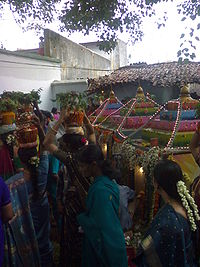
Sanskrit
Sanskrit , is a historical Indo-Aryan language and the primary liturgical language of Hinduism, Jainism and Buddhism.Buddhism: besides Pali, see Buddhist Hybrid Sanskrit Today, it is listed as one of the 22 scheduled languages of India and is an official language of the state of Uttarakhand...
words: Parikrama literally means "the path surrounding something" and Pradakshina
Pradakshina
Pradakshina or Pradakshinam , meaning circumambulation, consists of walking around in a 'circle' as a form of worship in Hindu ceremonies in India. The devotees walk around the sanctum sanctorum, the innermost chamber of the shrine housing the temple deity. It is done around sacred fire , trees and...
literally means: to the right (Dakshina means right) representing circumambulation
Circumambulation
Circumambulation is the act of moving around a sacred object.Circumambulation of temples or deity images is an integral part of Hindu ritual. It is also practised in Buddhism. In Islam, circumambulation is performed around the Kaaba in Mecca, in a counter-clockwise direction...
(Sanskrit: Pradakshina; ). Commonly, both words are mostly used as verb (as elaborated in following sections), in context to religious deities in a temple, sacred rivers, sacred hills and a close cluster of temples, and "doing" a parikrama as a symbol of prayer, is an integral part of Hindu worship
Worship in Hinduism
Worship in Hinduism is an act of religious devotion usually directed to one or more Hindu deities. A sense of Bhakti or devotional love is generally invoked. This term is probably a central one in Hinduism. A direct translation from the Sanskrit to English is problematic. Worship takes a multitude...
.
Most Hindu temple structures include various Parikrama or Pradaksina paths. Pradaksina paths are defined. as:
Circumbulatory or pathway around the shrine of the temples by keeping time is a common form of prayer in India. This pathway made of stone around the shrine is called Pradakshina path.
There could be one surrounding the main deity, other paths could be broader being concentric to the main path. However, it is not uncommon to find non-concentric parikrama paths in a single temple structure. At times the outermost parikrama path covers the whole village/town/city, thereby implying that the length of the path can stretch.
Parikrama is done around sacred fire (Agni
Agni
Agni is a Hindu deity, one of the most important of the Vedic gods. He is the god of fire and the acceptor of sacrifices. The sacrifices made to Agni go to the deities because Agni is a messenger from and to the other gods...
– the fire God), Tulsi
Tulsi
Ocimum tenuiflorum Ocimum tenuiflorum Ocimum tenuiflorum (also tulsi, tulasī, or Holy Basil is an aromatic plant in the family Lamiaceae which is native throughout the Old World tropics and widespread as a cultivated plant and an escaped weed. It is an erect, much branched subshrub 30–60 cm...
plant (Ocimum tenuiflorum) and Peepal tree. Parikrama of Agni or Agni Pradakshina is a part of the Hindu
Hindu
Hindu refers to an identity associated with the philosophical, religious and cultural systems that are indigenous to the Indian subcontinent. As used in the Constitution of India, the word "Hindu" is also attributed to all persons professing any Indian religion...
marriage ceremony.
Parikrama of the Narmada River
Narmada River
The Narmada , also called Rewa is a river in central India and the fifth largest river in the Indian subcontinent. It is the third largest river that completely flows within India after Ganges and Godavari...
, Govardhan hill
Govardhan hill
Govardhan is a hill located near the town of Vrindavan, in the Mathura district of Uttar Pradesh, India. It considered as sacred by a number of traditions within Hinduism....
, Vrindavan
Vrindavan
Vrindavan also known as Vraj is a town in the Mathura district of Uttar Pradesh, India...
, Vraj Mandala, Panchkosi, Lili and other practices (as explained in sections here) are performed.
Parikrama is also practiced in Buddhism
Buddhism
Buddhism is a religion and philosophy encompassing a variety of traditions, beliefs and practices, largely based on teachings attributed to Siddhartha Gautama, commonly known as the Buddha . The Buddha lived and taught in the northeastern Indian subcontinent some time between the 6th and 4th...
.
Legend
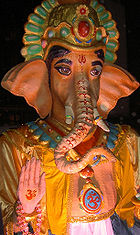
Shiva
Shiva is a major Hindu deity, and is the destroyer god or transformer among the Trimurti, the Hindu Trinity of the primary aspects of the divine. God Shiva is a yogi who has notice of everything that happens in the world and is the main aspect of life. Yet one with great power lives a life of a...
and his two sons illustrates the importance of Pradakshina or Parikrama. It is said that Lord Shiva
Shiva
Shiva is a major Hindu deity, and is the destroyer god or transformer among the Trimurti, the Hindu Trinity of the primary aspects of the divine. God Shiva is a yogi who has notice of everything that happens in the world and is the main aspect of life. Yet one with great power lives a life of a...
asked his two sons to circumambulate the universe to gain worldly knowledge. While his first son Shanmuga spent decades to go round the world on his peacock, his younger son Ganesha
Ganesha
Ganesha , also spelled Ganesa or Ganesh, also known as Ganapati , Vinayaka , and Pillaiyar , is one of the deities best-known and most widely worshipped in the Hindu pantheon. His image is found throughout India and Nepal. Hindu sects worship him regardless of affiliations...
walked a full circle around his father and justified his action by stating that the World
World
World is a common name for the whole of human civilization, specifically human experience, history, or the human condition in general, worldwide, i.e. anywhere on Earth....
was contained within Lord Shiva, his father. This legend justifies the importance that Hindus attach to the practice of Parikrama.
Narmada parikrama
The importance of the Narmada RiverNarmada River
The Narmada , also called Rewa is a river in central India and the fifth largest river in the Indian subcontinent. It is the third largest river that completely flows within India after Ganges and Godavari...
as sacred is testified by the fact that the pilgrims perform a holy pilgrimage of a Parikrama or Circumambulation
Circumambulation
Circumambulation is the act of moving around a sacred object.Circumambulation of temples or deity images is an integral part of Hindu ritual. It is also practised in Buddhism. In Islam, circumambulation is performed around the Kaaba in Mecca, in a counter-clockwise direction...
of the river. The Narmada Parikrama, as it is called, is considered to be a meritorious act that a pilgrim can undertake. Many sadhus (saints) and pilgrims walk on foot from the Arabian Sea
Arabian Sea
The Arabian Sea is a region of the Indian Ocean bounded on the east by India, on the north by Pakistan and Iran, on the west by the Arabian Peninsula, on the south, approximately, by a line between Cape Guardafui in northeastern Somalia and Kanyakumari in India...
at Bharuch
Bharuch
Bharuch , also known as Broach, is the oldest city in Gujarat, situated at the mouth of the holy river Narmada. Bharuch is the administrative headquarters of Bharuch District and a municipality of more than 1,50,000 inhabitants. As Bharuch is a major seaport city, a number of trade activities have...
in Gujarat, along the river, to the source in Maikal Mountains (Amarkantak
Amarkantak
Amarkantak is a pilgrim town and a nagar panchayat in Anuppur District in the state of Madhya Pradesh, India. Also called "Teerthraj" , Amarkantak region is a unique natural heritage area and is the meeting point of the Vindhyas and the Satpuras, with the Maikal Hills being the fulcrum...
hills) in Madhya Pradesh
Madhya Pradesh
Madhya Pradesh , often called the Heart of India, is a state in central India. Its capital is Bhopal and Indore is the largest city....
and back along the opposite bank of the river. It is a 2600 kilometres (1,615.6 mi) walk.. The Parikrama is also performed along the southern bank from its source (Amarkantak hills) to the mouth (Bharuch) and returning back along the northern bank, and it is considered to be of the highest religious efficacy.
Miraben (Marietta Madrell — sixty-year-old, born in London), a devotee who undertook this parikrama from Kabirwad in Gujarat in November 1998 and finished her pilgrimage at the same spot in February 2002, narrates her experience.:
— that India is the best place to seek spiritual peace — The Narmada Parikrama was not only a pilgrimage but a tapasya. I willingly endured the suffering and the parikrama was full of positive experiences — The river, the landscapes and the people, everything was beautiful.
During the Narmada Parikrama, devotees have to pass through a place called Shulpaneshwar ki Jhari, a religious place in Gujarat with links dating back to the Mahabharata
Mahabharata
The Mahabharata is one of the two major Sanskrit epics of ancient India and Nepal, the other being the Ramayana. The epic is part of itihasa....
epic story. The legend says that the Pandavas returning victorious from Kurukshetra
Kurukshetra
Kurukshetra is a land of historical and religious importance. Historically the land belonged to Punjab now a district in Haryana state of India. It is a holy place and is also known as Dharmakshetra . According to the Puranas, Kurukshetra is named after King Kuru, the ancestor of Kauravas and...
war were intercepted at Shulpaneswar by Eklavya and his group of tribal Bhils and looted them (Pandvaas) of all their belongings. Since then it is a custom that pilgrims on a Narmada Parikrama, while passing through this place, expect to be stripped of all their belongings leaving them with the bare essentials to carry on till some philonthropists give them donations on the way to carry on. With construction of the Sardar Sarovar Dam in Gujarat on the Narmada River
Narmada River
The Narmada , also called Rewa is a river in central India and the fifth largest river in the Indian subcontinent. It is the third largest river that completely flows within India after Ganges and Godavari...
, the Shulpaneshwar Temple has submerged under the reservoir, necessitating the pilgrims to take a circuitous route to continue on their journey.
Govardahan hill parikrama
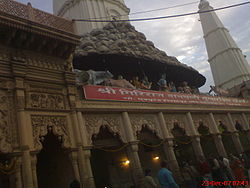
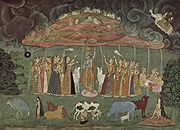
Govardhan hill
Govardhan is a hill located near the town of Vrindavan, in the Mathura district of Uttar Pradesh, India. It considered as sacred by a number of traditions within Hinduism....
which has great religious significance in view of its association with Lord Krishna, presently at its highest point is just 25 metres (82 ft) high and is a wide hill near Mathura Vrindavan
Vrindavan
Vrindavan also known as Vraj is a town in the Mathura district of Uttar Pradesh, India...
in Uttar Pradesh
Uttar Pradesh
Uttar Pradesh abbreviation U.P. , is a state located in the northern part of India. With a population of over 200 million people, it is India's most populous state, as well as the world's most populous sub-national entity...
, India
India
India , officially the Republic of India , is a country in South Asia. It is the seventh-largest country by geographical area, the second-most populous country with over 1.2 billion people, and the most populous democracy in the world...
. It is a narrow sandstone hill known as Giriraj which is about 8 kilometres (5 mi) in length.http://www.girirajji.com/goverdhan-parikrama.html Goverdhan Parikrama,Govardhan Parvat Parikrama,Govardhan Hill Parikrama,Parikrama of Goverdhan,Parikrama of Govardhan Parvat,Parikrama of Govardhan Hill
After Krishna protected the inhabitants of Vraj Vridavan from the wrath of Indra
Indra
' or is the King of the demi-gods or Devas and Lord of Heaven or Svargaloka in Hindu mythology. He is also the God of War, Storms, and Rainfall.Indra is one of the chief deities in the Rigveda...
, he counseled them to worship Govardhana hill and they did by way of a Puja (worship) and a Parikrama (circumambulation) around the hill.Thus, a festival in commemoration of the lifting of Mount Govardhan, near Mathura, by Krishna
Krishna
Krishna is a central figure of Hinduism and is traditionally attributed the authorship of the Bhagavad Gita. He is the supreme Being and considered in some monotheistic traditions as an Avatar of Vishnu...
came into vogue as 'Govardhan Puja' when Mount Govardhan is worshipped, the day after Deepawali (fetival of lights) is celebrated. Pious people keep awake the whole night and cook 56 (or 108) different types of food for the bhog (the offering of food to God) to Krishna. This ceremony is called 'ankut' or 'annakuta' which means a mountain of food. Various types of food – cereals, pulses, fruit, vegetables, chutneys, pickles, and salads – are offered to the Deity and then distributed as 'prasada' to devotees. Thousands of devotees bring offerings for Giriraj. Followed by this pooja, the devotees perform the Govardhana Parikrama.
Govardana Parikrama [circumambulation — going 21 kilometres (13 mi) around the hill] is a sacred ritual performed by many believers as spiritual purification. There is no time limit for performing this Parikrama, but for those who perform the dandavata (full prostration) Parikrama, an arduous form which may take weeks and sometimes even months to complete. Dandavata Parikrama is performed by standing in one spot, offering obeisances like a stick (danda) by lying flat on the ground and then continuing, contiguously, till the entire route is covered. It is also said that some sadhus (Hindu holy men) perform 108 obeisances in one spot before moving to the next. This can take a number of months to complete.
This ritual of Parikrama is considered to be even better if is it done with milk. A clay pot filled with milk, with a hole at the bottom, is carried by the devotees in one hand and a pot filled with dhoop (incense smoke) in another. An escort continuously fills up the pot with milk till the parikrama is completed. Parikrama is also done with candy being handed out to children, en-route.
Parikrama of Govardhana hill starts at the Manasi-Ganga Kund (lake) and then after having darsan of Lord Harideva, from Radha-kunda village, where the Vrindavan road meets the parikrama path. After parikrama of 21 kilometres, covering important tanks, shilas and shrines such as Radha Kunda, Syama Kunda, Dan Ghati, Mukharavinda, Rinamochana Kunda, Kusuma Sarovara and Punchari, it ends at Mansi Ganga Kund only.
Detail on goverdhan hill parikrama with video highlights- View the video and details
Vrindavan parikrama

Vrindavan
Vrindavan also known as Vraj is a town in the Mathura district of Uttar Pradesh, India...
town in Uttar Pradesh. It has no particular start or end place. As long as you end at the same place you start, the purpose is served. One possible path is to start from the famous ISKCON temple, covers a distance of 10 km (6.2 mi)in about three hours. It is generally done on Ekadasi (eleventh lunar day of the waxing
Waxing
Waxing is a method of semi-permanent hair removal which removes the hair from the root. New hair will not grow back in the previously waxed area for two to eight weeks, although some people will start to see regrowth in only a week. Almost any area of the body can be waxed, including eyebrows,...
and waning of Moon
Moon
The Moon is Earth's only known natural satellite,There are a number of near-Earth asteroids including 3753 Cruithne that are co-orbital with Earth: their orbits bring them close to Earth for periods of time but then alter in the long term . These are quasi-satellites and not true moons. For more...
). The route followed is from ISKCON temple, walk close to the Krishna
Krishna
Krishna is a central figure of Hinduism and is traditionally attributed the authorship of the Bhagavad Gita. He is the supreme Being and considered in some monotheistic traditions as an Avatar of Vishnu...
Balarama
Balarama
Balarama , also known as Baladeva, Balabhadra and Halayudha, is the elder brother of the divine being, Krishna in Hinduism. Within Vaishnavism Hindu traditions Balarama is worshipped as an Avatar of Vishnu, and he is also listed as such in the Bhagavata Purana...
Temple, the Krishna-Balarama tree, Gautam Rishi's Ashrama (located on the left while on the right is Varaha
Varaha
Varaha is the third Avatar of the Hindu Godhead Vishnu, in the form of a Boar. He appeared in order to defeat Hiranyaksha, a demon who had taken the Earth and carried it to the bottom of what is described as the cosmic ocean in the story. The battle between Varaha and Hiranyaksha is believed to...
Ghata), the Kaliya Ghata, Madana Mohana Temple with red sandstone tower, small wooden bridge, to Imli Tala, the Imli Tala tree, Sringara Vata (on the right), the Kesi Ghat (one of the famous Monuments in Vrindavan), the Tekari Rani temple, the Jagannatha temple and the small temple of Lord Chaitanya Mahaprabhu
Chaitanya Mahaprabhu
Chaitanya Mahaprabhu was a Vaishnava saint and social reformer in eastern India in the 16th century, believed by followers of Gaudiya Vaishnavism to be the full incarnation of Lord Krishna...
and in the final stretch cross the Mathura-Vrindavan road. After crossing this road, after another 1 km walking, reach the starting point of the Parikrama. During the Parikrama, one chants the mantras (Jap
Jap
Jap is an English abbreviation of the word "Japanese." Today it is generally regarded as an ethnic slur, although English-speaking countries differ in the degree to which they consider the term offensive. In the United States, Japanese Americans have come to find the term controversial or...
or Hymns ) within, uses body power (Tap
Tap
-Mechanical and electrical:* Tap , a device for controlling the release of a liquid or gas* Tap , part of an electrical device* A cutting tool, part of a tap and die set-Entertainment:* Tap dance...
) to accomplish the Parikrama and keeps a fast (not eat anything) (Vrata
Vrata
In the context of Hinduism and Hindu mythology, the term vrata denotes a religious practice to carry out certain obligations with a view to achieve divine blessing for fulfillment of one or several desires. Etymologically, vrata, a Sanskrit word , means to vow or to promise...
) till the Parikrama is completed.
Vraja Mandala parikrama
Since 1986, the Vraja Mandala Parikrama held during October–November is in vogue. It follows the same route taken by Sri Chaitanya MahaprabhuChaitanya Mahaprabhu
Chaitanya Mahaprabhu was a Vaishnava saint and social reformer in eastern India in the 16th century, believed by followers of Gaudiya Vaishnavism to be the full incarnation of Lord Krishna...
during his visit to Vrindavan
Vrindavan
Vrindavan also known as Vraj is a town in the Mathura district of Uttar Pradesh, India...
. Devotees achieve full experience of twelve forests of Vraja, over a period of one month and visit holy tirthas (pilgrimage centres) of Vraja (also spelt Braj
Braj
Braj is a region mainly in Uttar Pradesh of India, around Mathura-Vrindavan. Braj, though never a clearly defined political region in India but is very well demarcated culturally, is considered to be the land of Krishna and is derived from the Sanskrit word vraja...
). Vraja Mandala comprises twelve forests, known as vans, and twenty-four groves, known as upavans. The twelve forests are Madhuvan, Talavan, Kumudvan, Bahulavan, Kamavan, Khadiravan, Vrindavan, Bhadravan, Bhandiravan, Belvan, Lohavan, and Mahavan. The twenty-four groves are Gokul, Govardhan, Barsana, Nandagram, Sanket, Paramadra, Aring, Sessai, Mat, Uchagram, Kelvan, Sri Kund, Gandharvavan, Parsoli, Bilchhu, Bacchavan, Adibadri, Karahla, Ajnokh, Pisaya, Kokilavan, Dadhigram, Kotvan, and Raval all of which are stated to share in Lord Krishna’s absolute nature.
Panchkosi parikrama
In the temple city of Ayodhya in Uttar PradeshUttar Pradesh
Uttar Pradesh abbreviation U.P. , is a state located in the northern part of India. With a population of over 200 million people, it is India's most populous state, as well as the world's most populous sub-national entity...
, India, Panchkosi Parikrama is performed over a two day period. Devotees first take a holy dip in the Saryu River and then do a Parikrama of 15 km along the periphery of the city. It is said that over two hundred thousand devotees including around 50 thousand sadhus from Prayag (Allahabad
Allahabad
Allahabad , or Settled by God in Persian, is a major city of India and is one of the main holy cities of Hinduism. It was renamed by the Mughals from the ancient name of Prayaga , and is by some accounts the second-oldest city in India. It is located in the north Indian state of Uttar Pradesh,...
), Haridwar
Haridwar
Haridwar is an important pilgrimage city and municipality in the Haridwar district of Uttarakhand, India...
, Mathura and Kashi
Varanasi
-Etymology:The name Varanasi has its origin possibly from the names of the two rivers Varuna and Assi, for the old city lies in the north shores of the Ganga bounded by its two tributaries, the Varuna and the Asi, with the Ganges being to its south...
(Varanasi
Varanasi
-Etymology:The name Varanasi has its origin possibly from the names of the two rivers Varuna and Assi, for the old city lies in the north shores of the Ganga bounded by its two tributaries, the Varuna and the Asi, with the Ganges being to its south...
) participate in the parikrama, and full security arrangements are made for the religious occasion.
Lili parikrama
Lili Parikrama is a seven-day festival held at Mount GirnarGirnar
Girnar is a collection of mountains in the Junagadh District of Gujarat, India, situated near Junagadh at a distance of 327 km from Ahmedabad. It is a holy place and an important pilgrimage for both Hindus and Jains. There are a number of temples located here. Amidst the lush green Gir...
in Junagadh
Junagadh
Junagadh is the headquarters of Junagadh district in the Indian state of Gujarat. The city is the 7th largest in Gujarat. The city is located at the foot of the Girnar hills, 355 km south west of state capital Gandhinagar and Ahmedabad. The city is in western India. Literally translated,...
district of Gujarat, India. The pilgrimage involves a climb of 4,000 steps to reach the top to the sacred Mount Girnar venerated by both Hindus and Jains
Jainism
Jainism is an Indian religion that prescribes a path of non-violence towards all living beings. Its philosophy and practice emphasize the necessity of self-effort to move the soul towards divine consciousness and liberation. Any soul that has conquered its own inner enemies and achieved the state...
. The Jains call it Mount Neminath
Neminath
Neminatha was twenty-second Jain Tirthankar of the present age . According to Jain beliefs, he became a Siddha, a liberated soul which has destroyed all of its karma. He is also known as Arishtanemi He along with Rishabha or Adinatha is mentioned in the Rig Veda Samhita...
. Devotees from all over the country participate in the festival. Of the seven peaks of Girnar, five are important viz., Ambamata, Gorakhnath, Augadh, Guru Dattatreya and Kalika. Bhavnath Shiv temple, Bhartruchari cave, Sorath Mahal, Bhim Kund and Shiv Kund. Devotees visit these sacred places during the parikarama.
A different parikrama for Lord Shiva
In case of Maha Dev or Lord Shiva, there is a deviation in the Pradakhsina/Parikrama practice. The Pradaksina though taken clockwise is never completed round in this case. The devotees go round from one edge of the Gow Mukh (drainage opening from the Sanctum Sanctorum) to the other, but never cross the Gow Mukh or tread over the area but turn back anticlockwise till they reach the other side of the Gow Mukh. Only ‘trained’ personnel cross into that area for maintenance.Buddhist practice
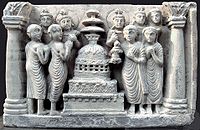
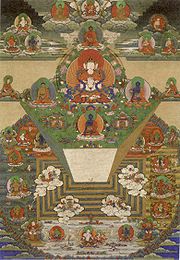
Stupa
A stupa is a mound-like structure containing Buddhist relics, typically the remains of Buddha, used by Buddhists as a place of worship....
into the stupa shrine — as a sacred entity which requires a circumambulatory path around it for the purpose of worship. The whole structure is planned in such a way that it becomes the centre of the mandala and symbolically represents Mount Meru.
Symbolism
The temple structure reflects the symbolism of the Hindu association of the spiritual transition from daily life to spiritual perfection as a journey through stages. Parikrama paths are present through which worshipers move in a clockwise direction, starting at the sanctuary doorway and moving inward toward the inner sanctumSanctum sanctorum
The Latin phrase sanctum sanctorum is a Latin translation of the biblical term: "Holy of Holies" which generally refers in Latin texts to the Holiest place of the Tabernacle of Ancient Israel and later the Temples in Jerusalem, but also has some derivative use in application to imitations of the...
where the deity is enshrined. This represents translation of the spiritual concept of transition through levels in life into bodily movements by the worshipers as they move inwardly through ambulatory halls to the most sacred centre of spiritual energy of the deity.
Shayana Pradakshinam
Shayana Pradakshinam is done in a lying posture. It starts with a Sashtanga Namaskara in front of the sanctum sanctorum. In Sashtanga Namaskara, the devotees have eight parts of their bodies touching the ground. Thus forehead, chest, shoulders, hands and knees touch the ground. The folded hands will be directed always towards the deity. In this pose, the devotees circumambulate on the Pradakshina path. The relatives and friends of the devotees help them to roll around. This is a tedious ritual.Number of Pradakshinas
For each deity, the minimum number of Pradakshinas to be done are specified.-
-
- Ganesha: 1
- Shiva: 2
- Vishnu: 3
- Ayyappa: 4
- Subrahmanya (Karthikeya): 5
- Durga: 6
- Peepal Tree: 7
-
The Swayambhu Agama says that doing Pradakshina 21 times to any deity is sanctified.

